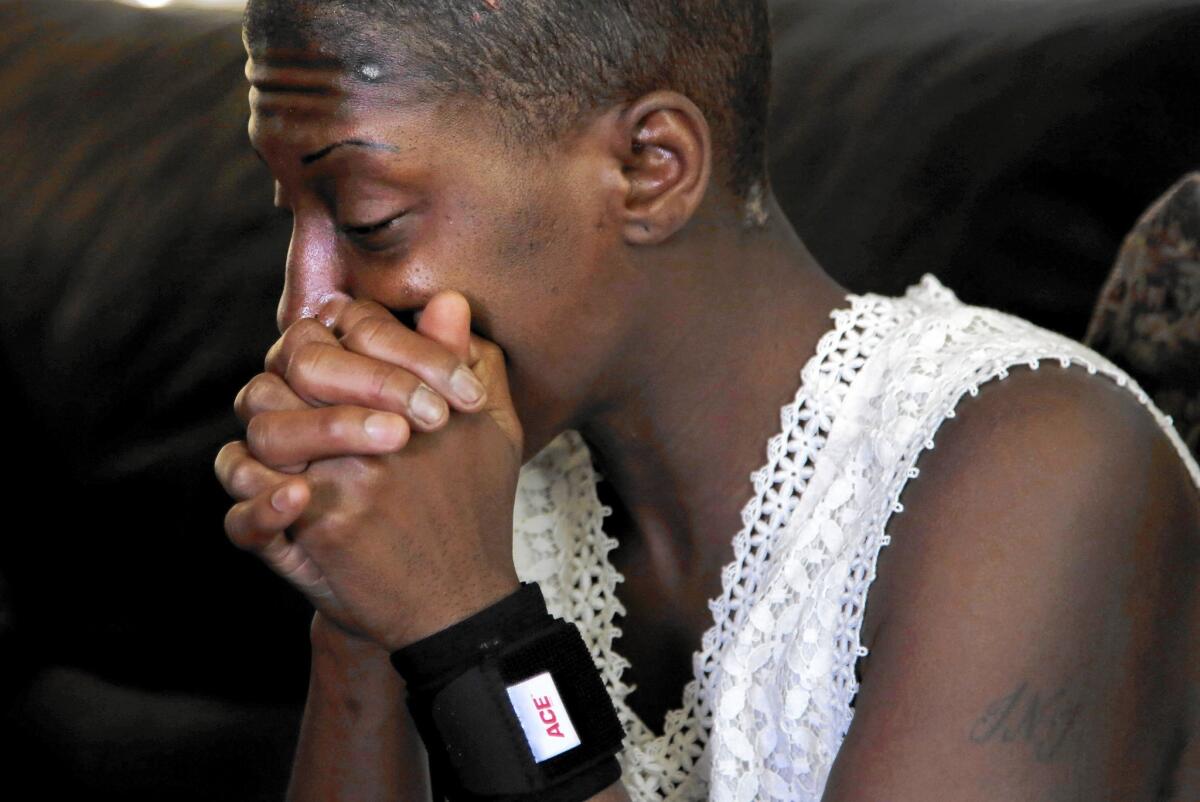Mentally ill woman in LAPD assault a case study in system’s lapses

After a court hearing examining county inmate Trishawn Carey’s extensive medical and mental health history, a judge last month ordered her released to the care of a South Los Angeles residential treatment program for women just out of jail or prison.
Two days later, the Los Angeles County Sheriff’s Department dropped the homeless woman at the emergency room entrance of the county hospital. She ended up on skid row, where supporters found her five hours later at the scene of her March 1 arrest, without any medication.
Carey faces life in prison on a charge of assaulting an officer for raising a nightstick during the fatal police shooting of Charly Keunang, another skid row ex-convict with a history of mental illness. An insulin-dependent diabetic, Carey had been prescribed psychotropic drugs for spells of psychosis and clonazepam for seizures and panic, lived off Social Security tied to her mental disability — a doctor diagnosed her with schizoaffective disorder — and cycled in and out of Los Angeles County jails 10 times since 2002, a report to the court said.
Over the last month, Los Angeles County Dist. Atty. Jackie Lacey and Sheriff Jim McDonnell have pledged sweeping reforms of the justice system’s chronically poor treatment of mentally ill inmates. Advocates for the mentally ill and homeless say that the entire county system is broken. Inmates such as Carey with severe psychological diagnoses repeatedly fall through the cracks and land back on the streets, even when housing is available, they say.
“Too often, homeless people with significant disabilities and health problems are just dumped back on the street, from which they cycle through the police stations, courts, jails and then back to the street — all at great cost to taxpayers as well as the health of poor people with disabilities,” said retired UCLA professor Gary Blasi, a longtime Los Angeles homelessness researcher and advocate.
“This happens every day, if not many times a day,” said Marsha Temple of the Los Angeles-based nonprofit Integrated Recovery Network, which helps newly released inmates secure housing and jobs. “We’ve lost people, just lost them.”
Assistant Sheriff Terri McDonald, who oversees the jails, said the county is taking steps to plug the holes, including a June decision by the Board of Supervisors to integrate jail mental health, custodial and medical departments.
The sheriff last week agreed to federally supervised reforms, including ensuring that inmates are released with medication and access to psychological counseling. Lacey’s plan, released in July, focuses on training law enforcement to defuse encounters with mentally ill people and on developing treatment housing.
But with more than 3,000 people in the county’s jail system — about one-fifth of the total — requiring mental health services, and 10,000 inmates in and 10,000 inmates out each day, it’s a challenge, McDonald said.
“This is the kind of case that highlights how we could have done something different or better,” McDonald said.
A spokesman said Lacey was looking into the Carey case but was unavailable for comment.
During Carey’s July 22 court hearing, Deputy Dist. Atty. Greg Denton argued against her release, saying that she needed the “serious and constant care” jail could provide for her disabilities.
Judge Ray Jurado reduced Carey’s $1-million bail to $50,000 and made her release conditional on entering A New Way of Life Reentry Project, according to court records.
Carey posted bail July 24 at 12:30 a.m. Sheriff’s officials said the court’s release order made no mention of A New Way of Life, or any other destination.
“There was no indication on the court remand order of 7/22 that she be released to the care of anyone,” county Department of Mental Health Director Marvin Southard said in an email.
Carey was evaluated by a psychiatrist and medical personnel, resulting in a decision to take her by ambulance to Los Angeles County-USC Medical Center, Southard said. One of Carey’s lawyers, Monique Noel, said Carey was left at the emergency room entrance.
Her attorneys said it wasn’t clear how she got to skid row. Milton Grimes, who represented her at the hearing, said Carey’s defense team and supporters were waiting for word from the bail bondsman or the jail that Carey had been processed, which typically takes 12 to 72 hours. When they didn’t hear anything, lawyers phoned the jail and learned she was gone, Grimes said.
The Los Angeles Community Action Network, a skid row advocacy group that has protested the charges against Carey, canvassed the community and found her at San Pedro and 5th streets, where she watched Keunang get shot and killed by police, Pete White of the advocacy group said.
“She was vulnerable to rearrest, vulnerable period,” White said. “She didn’t know what the next steps were for her. If we hadn’t found her she’d still be on the streets now.”
Susan Burton, A New Way of Life’s director, said she spent more than 10 hours over two days replacing medication that Carey had been getting in jail.
“Insulin is a crisis medication,” Burton said. Burton and Temple said inmates can dissolve upon leaving jail without continuing their drug regimen.
“It’s important the sheriff and the D.A. work with the community to realize real-world solutions,” Burton said. “If they make decisions in silos it will fall short.”
ALSO:
Kamala Harris’ office indicts 32 Long Beach Crips and associates
Gov. Brown doesn’t want California to use this word for immigrants
In a first, California agrees to pay for transgender inmate’s sex reassignment
More to Read
Sign up for Essential California
The most important California stories and recommendations in your inbox every morning.
You may occasionally receive promotional content from the Los Angeles Times.











